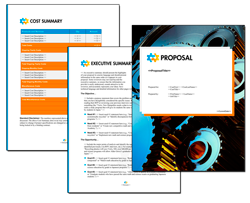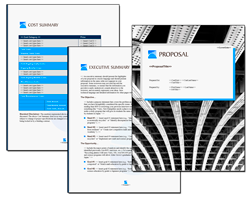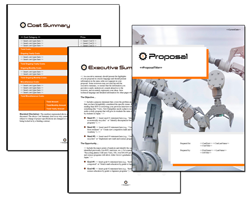
Your Guide on How to Write an Engineering Proposal
Creating an engineering proposal is key to winning projects and funding. Here, we demystify how to write one, covering the necessary elements from outlining your method to nailing the financial pitch. Learn to articulate your capabilities and align with client goals for a proposal that delivers results.
Key Takeaways
- Engineering proposals should be tailored to their intended audience and type of project, clearly defining the project scope, client needs, and the structured narrative.
- The proposal must demonstrate the team's expertise and experience. It must also include a detailed project methodology that outlines work steps, addresses potential risks, and provides a clear financial overview with justified costs.
- Enhancing proposals with engaging visuals and supporting documents and ensuring careful finalization and compliance with RFP requirements are critical to a successful submission and establishing professionalism.
Types of Engineering Proposals

Engineering proposals are as diverse as the field, ranging from academic research funding requests to complex business proposals for massive civil engineering projects. In engineering services, a proposal serves as your introduction to future opportunities, potentially paving the way for long-term partnerships or high-stakes projects.
Whether you're an academic seeking grant money, an in-house engineer vying for project approval, or a consultant creating a bid for an external client, each engineering service proposal must be tailored to its audience, to their specific needs and project requirements.
Specialized fields like Automation Engineering blend mechanical, electrical, and software engineering that define the next generation of technology.
Each proposal, whether a detailed business proposal or a succinct project pitch, serves as an ambassador of your expertise, a narrative of your proposed project, and a roadmap of the proposed work.
- Project Feasibility Study Proposal: This proposal outlines the feasibility of a proposed engineering or automation project, detailing the technical, economic, and operational aspects.
- Design and Development Proposal: Includes detailed plans and specifications for designing and developing an engineering solution or automation system.
- System Integration Proposal: A proposal for integrating various subsystems into a single, cohesive system, often involving complex automation processes.
- Process Improvement Proposal: This proposal aims to enhance existing engineering processes or automation systems to increase efficiency, reduce costs, or improve quality.
- Research and Development Proposal: A proposal focused on conducting research and developing new technologies or methodologies in engineering and automation.
- Implementation Proposal: This outlines the steps and resources required to implement a new engineering project or automation system, including timelines and cost estimates.
- Maintenance and Support Proposal: A proposal detailing the maintenance and ongoing support services for engineering systems or automation solutions to ensure they continue to operate effectively.
- Equipment Procurement Proposal: This involves procuring specific engineering or automation equipment, including justification, specifications, and cost analysis.
- Safety and Compliance Proposal: A proposal ensuring that engineering projects or automation systems comply with safety standards and regulatory requirements.
- Training and Education Proposal: This proposal focuses on providing personnel with training and education on new engineering technologies or automation systems to ensure effective utilization.
Here are some related samples included in every downloadable Proposal Pack
The AI Writer generates a first draft of these templates - customized to your company, client, and project - in just minutes, giving you a head start on editing. Get any Proposal Pack or Proposal Kit Professional, and all of these samples, and the AI Writer are included.
- Custom Home Building Proposal
- Environmental Program Sample Proposal
- Energy Efficiency Sample Proposal
- Environmental Cleanup Sample Proposal
- Software and Hardware System Sample Proposal
- Manufacturing Process Improvement Sample Proposal
- Patent and Invention Licensing Proposal
- Architectural Design Sample Proposal
- Manufacturing and Distribution Sample Proposal
- Mining Safety Sample Proposal
- 3D Printing Prototyping Services Sample Proposal
- Smart Home Automation Project Sample Proposal
- Robotics Automation Project Sample Proposal
Here are some related downloadable templates
The AI Writer generates a first draft of these templates - customized to your company, client, and project - in just minutes, giving you a head start on editing. Get any Proposal Pack or Proposal Kit Professional, and all of these templates and the AI Writer are included.
- 3D Printing Services Proposal Template
- 3D Printing and Prototyping Services Proposal
- AI Powered Domestic Manufacturing Proposal Template
- Advanced Manufacturing Proposal Template
- Advanced Robotics Integration Proposal Template
- Automation of Facilities and Production Proposal
- Automation of Manufacturing Processes Proposal Template
- Collaborative Robotics Manufacturing Proposal Template
- Drone Delivery of Supplies in Disaster Area Proposal
- Electrical Engineering Project Proposal
- Industrial Automation Proposal
- Industrial Controls System Design and Implementation Proposal
- Machining Services Proposal
- Retooling Production Line Proposal
- Reusable Component Design Proposal
- Robot Design Project Proposal
- Robotics Automation Project Proposal
- Vessel Repair and Modification Proposal Template
- Vessel Repair and Modification RFP Template
- Vessel Repair and Upgrade Project Proposal
- Automation Of Manufacturing Processes Proposal Template
Understanding the Essentials of an Engineering Proposal
An engineering proposal fundamentally serves as a document, mirroring your company's readiness and professionalism. It's a structured narrative showcasing your project proposal writing skills and your ability to understand and meet the client's needs when writing engineering proposals.
Presenting a concise, comprehensive business proposal with a clearly defined project scope proves you are a qualified engineering consultant best suited for the task.
Defining Your Project Scope

The project scope is fundamental to any engineering proposal. It details the work steps, deliverables, and timelines. A well-defined project scope aligns with the client's expectations and company goals, minimizing misunderstandings and setting the stage for the project's success.
It's not just about what's included; it's equally about what's not. By delineating the project's limitations and constraints, you provide a clear picture of precisely what the proposed task entails and its boundaries.
Client Needs Assessment
A successful engineering proposal hinges on understanding and addressing the client's needs. It's about connecting with the potential client, demonstrating an appreciation for their unique challenges, and aligning your proposed project with their vision. This client-centered approach, starting from the very first lines of your proposal, can significantly increase your chances of resonance with the client and ultimately secure the project.
The Role of a Structured Proposal
More than a project plan, a structured proposal exhibits your team's communication skills and management capabilities. A proposal tailored to the client's project requirements and presented with clarity illustrates professionalism that speaks volumes. It signals to the client that you are an organized team that can deliver the proposed work efficiently and effectively.
A tool like Proposal Kit can be instrumental in ensuring that your proposal statement has a solid structure, which enhances the presentation of your team's abilities and project plan.
Creating a Compelling Introduction
The introduction is the point to capture interest in your engineering proposal. It's your chance to captivate the reader with an engaging cover letter that expresses your enthusiasm for the project. It's about personalizing the experience and highlighting key points that will be expanded upon throughout the proposal.
The title page, featuring the project's title, relevant information, and the project background section, should lay the groundwork for what is to come, introducing your organization and the problem or opportunity.
Executive Summary Creation

The executive summary serves as your engineering proposal's condensed, compelling overview. It's a snapshot that must convey the essence of your entire proposal, highlighting your approach and the value you bring. This section should clarify the necessity of the proposed work and resonate with the client's needs.
Creating a concise and compelling executive summary is critical to ensure that your proposal grabs attention and maintains it throughout.
Designing an Impactful Cover Letter
The cover letter adds a personal touch, complementing the formal aspects of your proposal. It's where you introduce your organization and articulate your unique pitch. This is your opportunity to connect with your client, assuring them that you understand their concerns and are ready to deliver competitive advantages.
Concluding with a statement reiterating your strengths and the value proposition will reinforce your organization's capabilities and genuine interest in the project.
Showcasing Your Qualifications and Experience
The strength of a proposal is determined by the competence of the team behind it. This section is where you showcase your organization's collective expertise, detailing the journey, achievements, and extensive experience that set you apart.
By presenting your qualifications and experience in a manner that addresses the decision maker's interests, you establish credibility and provide a reason why your team is best suited for the proposed work.
Highlighting Company Credentials

Your company's background is a testament to its capability to deliver on the promises made in the proposal. Highlighting your credentials, such as completed projects and unique resources, reinforces the strength of your team and can be a significant factor in winning the proposal.
Visual representations, such as high-quality images and team photos, can amplify the impact of your credentials and make them more relatable.
Profiling the Project Team
Individual team members bring a wealth of expertise to the table. Detailing each team member's roles, responsibilities, and qualifications demonstrates the depth and diversity of your project team's talent.
Detailed Project Methodology
The project methodology section details your comprehensive plan of action. It's a detailed blueprint that explains how you intend to navigate the project from start to finish. Using Proposal Kit's templates, you can ensure this section is engineered to perfection, offering a clear overview of the approach, techniques, and management steps required for successful execution.
Outlining the Work Steps
The effectiveness of a project relies on its execution; hence, outlining the work steps becomes crucial. This section acts as a roadmap, presenting the approach and defining the roles and responsibilities. It's about breaking the project into manageable phases and providing a detailed work schedule, including key milestones, deadlines, and dependencies.
Addressing Potential Risks
Addressing the inherent risks of any project in your engineering proposal highlights your foresight and readiness. By detailing specific risk mitigation strategies and contingency plans, you convey a comprehensive understanding of potential pitfalls and how you plan to manage them, instilling confidence in the client.
Financial Aspects: The Cost Section
The cost section is the primary area where financial details are presented. Here, you present a clear financial overview of the project, categorizing expenses and assigning monetary values to each. This section should clearly outline the project's cost, ensuring that the client understands the value they are receiving for their investment.
Itemizing Project Expenses

Categorizing project expenses into separate groups promotes transparency. By itemizing individual labor charges, material costs, and other expenses, you offer a detailed breakdown that allows the client to see precisely where their investment goes. This clarity is critical to building trust and highlighting the thoroughness of your proposal.
Justifying Costs in Relation to Value
Cost justification in your project goes beyond enumerating expenses; it entails illustrating the value of each dollar spent. This section should explain why specific costs are necessary and how they directly contribute to the project's success, ensuring the client sees the value proposition.
Visual Enhancements and Supporting Documents
Including visual enhancements and supporting documents can influence the success of your proposal. Incorporating visuals like charts, photos, and infographics clarifies complex information and helps make your proposal more memorable.
Incorporating Engaging Graphics
Engaging graphics can make a good proposal outstanding. Strategically using visual elements such as charts and infographics can replace excessive language, making the proposal more accessible and appealing.
Civil engineering proposals, in particular, benefit from clear visual representations that can convey design concepts more than text.
Including Important Documentation

Adding supplementary documents like certifications and testimonials enhances the credibility of your proposal. Choosing the right visuals to accompany these documents can make them more engaging and trustworthy.
Pairing testimonials with corresponding headshots or logos can reinforce the authenticity and reliability of your previous work.
Finalizing and Submitting Your Proposal
Finalizing your engineering proposal is a decisive stage that requires a keen eye for detail and strict compliance with RFP requirements. This is the moment to ensure your proposal is polished, error-free, and ready for submission. Meeting the submission deadline is not just a formality; it's a demonstration of your professionalism and an indication of your reliability and organizational skills.
Proofreading and Compliance
Proofreading is essential in ensuring clarity, conciseness, and error-freeness in your proposal. Compliance with the RFP requirements is just as crucial as failing to meet these criteria can lead to disqualification.
Using tools provided by Proposal Kit can assist in this process, helping you to write proposals that are not only compelling but also in perfect alignment with the client's expectations.
Submission Strategies
Adopting an approach to proposal submission goes beyond merely meeting project deadlines. It's about demonstrating a commitment to the project from the outset and showing that your team can manage time effectively.
Timely submission can enhance your reputation and solidify the trust of potential clients.
 Proposal Kit Professional provides the most content, including legal contracts and a free design theme pack. Plus, advanced software features include custom branding and customizable quoting databases.
Proposal Kit Professional provides the most content, including legal contracts and a free design theme pack. Plus, advanced software features include custom branding and customizable quoting databases. Proposal Pack for Any Business covers this type of proposal and includes samples. There are also some commonly used specialty design themes available:
Proposal Pack for Any Business covers this type of proposal and includes samples. There are also some commonly used specialty design themes available:Photo Design Proposal Packs
Line Art Design Proposal Packs
 Proposal Pack Aerospace #1
Proposal Pack Aerospace #1 Proposal Pack Aerospace #2
Proposal Pack Aerospace #2 Proposal Pack Classic #12
Proposal Pack Classic #12 Proposal Pack Classic #6
Proposal Pack Classic #6 Proposal Pack Concepts #1
Proposal Pack Concepts #1 Proposal Pack Concepts #4
Proposal Pack Concepts #4 Proposal Pack Concepts #5
Proposal Pack Concepts #5 Proposal Pack Contemporary #1
Proposal Pack Contemporary #1 Proposal Pack Contemporary #6
Proposal Pack Contemporary #6 Proposal Pack Global #1
Proposal Pack Global #1 Proposal Pack Global #2
Proposal Pack Global #2 Proposal Pack Global #3
Proposal Pack Global #3 Proposal Pack In Motion #2
Proposal Pack In Motion #2 Proposal Pack Industrial #1
Proposal Pack Industrial #1 Proposal Pack Industrial #2
Proposal Pack Industrial #2 Proposal Pack Industrial #4
Proposal Pack Industrial #4 Proposal Pack Tech #5
Proposal Pack Tech #5 Proposal Pack Tech #6
Proposal Pack Tech #6
Summary
We've discussed many engineering proposals, uncovering the strategies and techniques that can transform a simple document into a powerful tool for success. From the initial understanding of types and essentials to the final submission strategies, each section of this guide has aimed to equip you with the knowledge to write an engineering proposal that resonates with clients and conveys your team's capabilities. Mastering proposal writing is not just about following a template; it's about telling a story that aligns with your client's vision and showcases your unique value.
Frequently Asked Questions
What are the critical components of an engineering proposal?
An engineering proposal should include a clear project scope, an understanding of client needs, a structured format, a compelling introduction, detailed qualifications and experience, a thorough project methodology, a transparent cost section, engaging visuals, supporting documents, and meticulous proofreading.
How can the Proposal Kit help write engineering proposals?
Using Proposal Kit for writing engineering proposals can provide access to templates, a quoting system, and proposal creation software, simplifying the process of creating professional, tailored proposals for specific client needs and project requirements.
What visual elements should be included in an engineering proposal?
An engineering proposal should include visual elements like charts, flowcharts, infographics, diagrams, illustrations, maps, high-quality project images, and team photos to represent data, explain processes, highlight benefits, and showcase past successes.
How important is the project scope in an engineering proposal?
The project scope is crucial in an engineering proposal as it establishes clear objectives, activities, and limitations, ensuring mutual understanding and setting expectations for project success.
Can you explain the significance of the cost section in a proposal?
The cost section in a proposal is significant because it itemizes and justifies each expense, building trust with the client and helping them understand the total cost and the value they are receiving. This can be a deciding factor in whether the proposal is accepted.



 Cart
Cart
 Are you just looking for a template, sample, or software for your engineering or automation proposals? Click these links to skip down the page and get right to it.
Are you just looking for a template, sample, or software for your engineering or automation proposals? Click these links to skip down the page and get right to it.











 Facebook
Facebook YouTube
YouTube Bluesky
Bluesky Search Site
Search Site